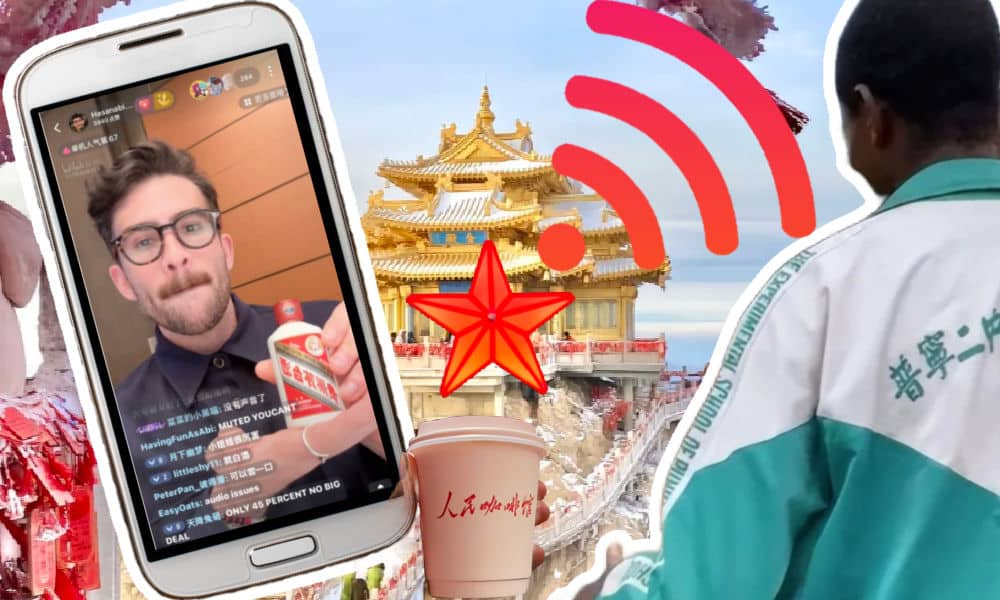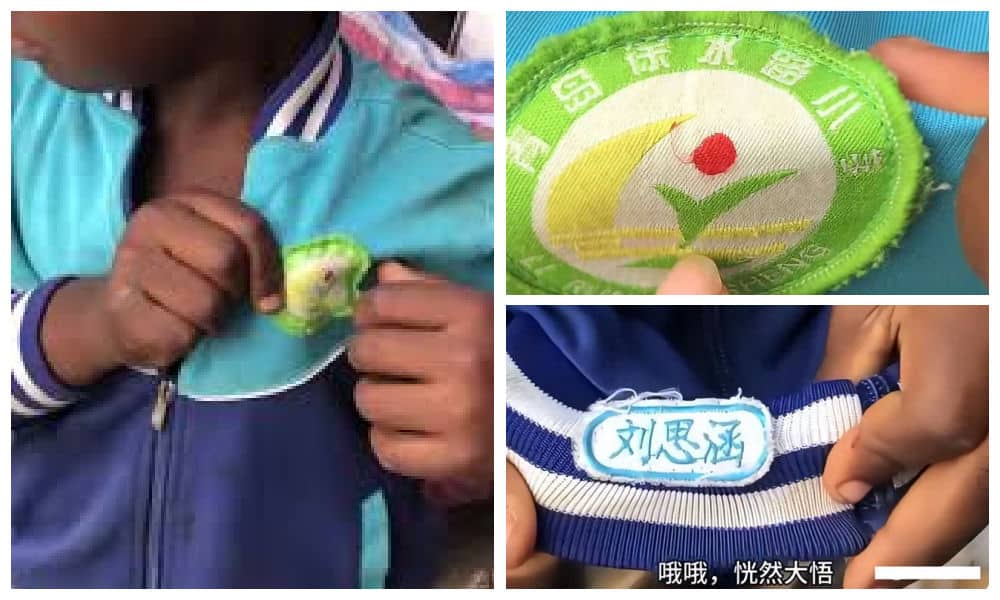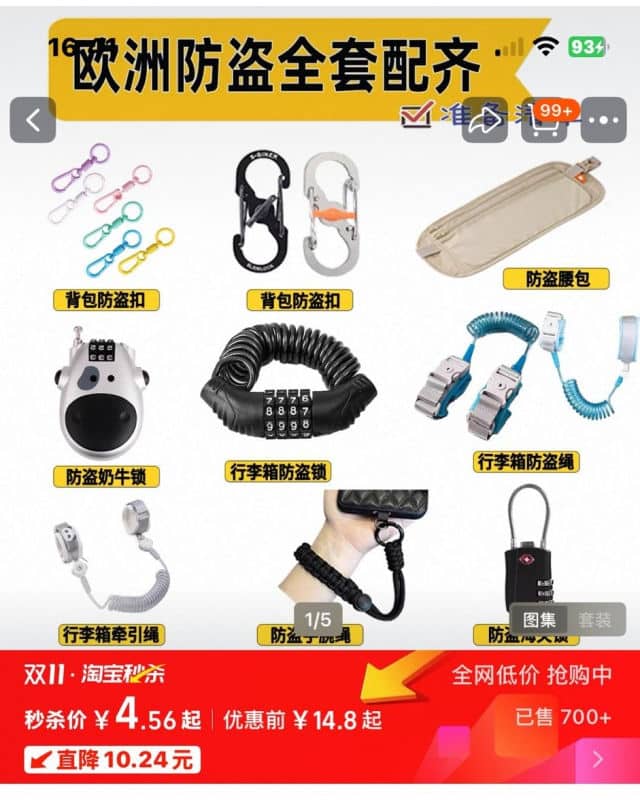Featured
Weibo Watch: The Land Rover Woman Controversy Explained
‘Land Rover Woman’ is more than just the Chinese equivalent of the American ‘Karen’ meme. Understand why this viral story is shaking things up, and read about the trending topics that matter this week.
Published
1 year agoon

PREMIUM NEWSLETTER | ISSUE #36
This week’s newsletter:
◼︎ 1. Editor’s Note – Landrover Woman Controversy
◼︎ 2. What’s New and Noteworthy – A closer look at featured stories
◼︎ 3. What’s Trending – Hot highlights
◼︎ 4. What’s Noteworthy – South Korean women ask for help on Weibo
◼︎ 6. What’s Popular – The contagious success of Black Myth: Wukong
◼︎ 7. What’s Memorable – Train Tyrant Woman
◼︎ 8. Weibo Word of the Week – Armless Flying Fish
Dear Reader,
One can become a meme overnight. There are many people who could tell you all about it, from the Subway Judge to the Train Tyrant. This week, it’s ‘Land Rover Woman’ who has become the latest addition to the Chinese Lexicon of Viral Incidents.
The incident, which we detailed in our recent article, occurred on August 28. In short: a woman in a white Range Rover, complete with a Chanel logo, became enraged when another driver refused to yield as she attempted to force her way into traffic while driving in the wrong direction. In the middle of a congested road, she exited her vehicle and caused a scene. She screamed, pointed, kicked the other car, and ultimately yanked open the driver’s door of the man who blocked her path, proceeding to hit him in the face. She then drove off (see video here).

Land Rover Woman during the incident.
The man, blood dripping from his nose, remained calm and did not retaliate, explaining afterward that he chose not to strike back because his children were in the back seat. The woman, identified as 36-year-old Wang from Qingdao’s Laoshan district, was subsequently handed 10 days of administrative detention and fined 1,000 yuan (approximately $140).
As footage of the incident went viral on Chinese social media, it sparked widespread debate.
The man, later revealed to be a former member of the military, spoke to reporters a day after the altercation, stating that it had left him not only physically hurt but also mentally distressed. He announced that he was preparing to take legal action against the woman and would not accept mediation.
The man, Lin, received overwhelming support from Chinese netizens, who saw the situation as an injustice on multiple levels.
Gender Dynamics
The woman physically assaulted the man, who chose not to defend himself—not because he couldn’t, but because of social norms, his responsibilities as a father, and his background in the military.
This dynamic has triggered discussions about the double standards in how aggression is viewed depending on gender and how a “real man” (真汉子) would and should respond in such a situation.
Some commenters suggested that the man “lost face” by being hit by a woman without fighting back, especially given his military background. Others argued the opposite, saying his restraint proved he truly was a “real man.”
Regardless, both perspectives agree that Chinese societal norms put the man in an unfair, vulnerable position.
Social Privilege
A major factor in the controversy revolves around social privilege. The woman’s entitled behavior—saying “So what if I hit you?” (“打你怎么了”)—and her driving a luxury 1.3 million yuan ($180,000) Range Rover with a Chanel logo contrasted sharply with Lin, a decommissioned soldier running a local guesthouse who was simply traveling with his children.
Many netizens saw this as a clear example of social class injustice, a power imbalance between a wealthy woman and a working-class man. Wang’s sense of entitlement allowed her to believe she could act violently without facing real consequences. The outrage was further amplified by Lin’s former military service, a profession meant to protect others, making the incident feel even more unjust.
Legal Disparities
Perhaps the biggest point of contention in the Land Rover Woman controversy is the perceived leniency of the punishment. The woman received 10 days of administrative detention and a small fine, but many netizens feel her actions amount to disorderly behavior (“picking quarrels and provoking trouble” 寻衅滋事罪), which has seen far harsher penalties in cases with less public impact.
The light sentence is viewed by many as a failure of the legal system to adequately address the severity of the incident, especially given the public nature of the attack and its broader social implications.
This has led to people seeking justice in their own ways. Some people started calling the Qingdao city hotline, directly expressing concerns to local authorities that the sentence given to ‘Land Rover Woman’ is too lenient. Others took matters into their own hands through digital vigilantism, attempting to track Wang’s whereabouts to ensure she was being properly detained. Earlier this week, her license plate went viral, with livestreamers filming her car as it was spotted in the streets.
Beyond the “Karen” Meme
As this incident has sparked online conversations about fairness and accountability, ‘Land Rover Woman’ has also become an internet meme.
With her black face mask, summer hat, long hair and white dress, she has become a recognizable figure, embodying the kind of woman everyone loves to hate. She’s poppping up in various photoshopped images and AI-generated videos. Even car stickers have been made featuring her image alongside the now infamous quote, “So what if I hit you?””1

Various “Land Rover Woman” AI-generated images published on Xiaohongsu.

Car sticker “So What If I Hit You?”
‘Land Rover Woman’ is more than just the Chinese equivalent of the American “Karen” meme, which depicts a stereotypically entitled, middle-aged white woman who often complains or picks fights. Land Rover Woman is not just entitled and rich, she also embodies netizens’ frustration over what they see as an imbalance in how justice is applied across gender and social class.

‘Film poster’ published on Weibo: “逆行的血案“: “The Bloody Wrong-Way Incident”
Turning her into a meme has become a form of social critique. By making Land Rover Woman part of China’s larger digital discourse, it has also become a way for netizens to seek justice. For Wang, becoming an internet meme and a target of public outrage is likely to have a far greater impact on her daily life than a ten-day detention.
Miranda Barnes contributed to the compilation and interpretation of some topics featured in this newsletter. Ruixin Zhang has authored the ‘What’s Noteworthy’ section.
Personal Note: I’ll be traveling in China for the next two weeks, so the upcoming newsletter might arrive a bit later than usual. However, rest assured, I’ll return with fresh insights. Not long ago, I covered the ‘robotaxi revolution’ in Wuhan, now the world’s largest city for driverless taxis. I’ll be heading there to explore the latest AI trends and see the developments firsthand. Have any specific questions about robotaxis? Let me know!
Best,
Manya Koetse
(@manyapan)
1 AI images from Xiaohongshu by AI老白, 忙到七点的麻辣香锅, 视野洞见PPT. Car sticker images by 小文分享.
What’s New

The Paralympic File | Following China’s golden success at the 2024 Paris Olympics, the spotlight now shifts to the Paralympics (残奥会), running from August 28 to September 8, 2024. While not as widely followed as the Olympics, the Paralympics still garnered significant attention on Chinese social media, where many athletes are celebrated not so much as national heroes, but as champions of their home regions.

Road Rage | What possessed the female driver of a Land Rover to drive against traffic, cut in line, and assault another driver? This incident has dominated trending topics on Chinese social media over the past week—not just because of the woman’s behavior, but also because of how the victim responded and the legal fallout. See article, video link included.

Bump in the Road | A viral court case in China has sparked debate after a female employee was fired shortly after announcing her pregnancy. While the company cited “poor performance,” the courts ruled in her favor. The case highlights the ongoing issue of pregnancy discrimination in Chinese workplaces, but also reveals the mixed feelings people have about women who may be seen as taking advantage of the system.
What’s Trending
🛑 Edible Oil Scandal Update & Goji Controversy
On August 25, China’s State Council Food Safety Office, alongside several other government agencies, released the results of their investigation into a cooking oil scandal that shocked the nation earlier this year. The scandal involved edible oil being transported in tankers that had previously carried chemicals and waste, raising serious food safety concerns. The investigation uncovered multiple violations of food safety laws across Hebei, Tianjin, Inner Mongolia, and Shaanxi, including failures to properly clean tankers before transporting food products and attempts to cover up these actions. Nationwide inspections reportedly have not found similar issues in other regions so far. The government has since imposed significant penalties, including a $400,000 fine on Sinograin Oil and a total of $1.1 million in fines on six other logistics and edible oil companies. Additionally, criminal charges have been filed against two drivers involved in the illegal activities.
While people are still concerned about the safety of their cooking oil, another food safety controversy has popped up again. CCTV-2 recently exposed that some merchants in Gansu have been illegally using industrial sulfur to fumigate goji berries to enhance their appearance and boost profits. Industrial sulfur, which contains high levels of arsenic, is not approved for food processing. Though the berries may look appealing, they are toxic, further fueling netizens’ fears about hidden dangers in other food products.
💍 Huang Zitao’s Three Years of Mourning
Chinese celebrity Huang Zitao (黄子韬) has been the center of attention lately. The former EXO member recently announced his engagement to fellow singer Xu Yiyang (徐艺洋). Both artists appeared on the reality show Dare Or Not, where Huang’s proposal to Xu was featured in the final episode. The couple had publicly confirmed their relationship in July, following years of dating rumors.
It has now come to light that Huang Zitao allegedly chose to observe a three-year mourning period in honor of his late father before announcing any major personal news. After the mourning period ended, he began preparing to publicly share his relationship and marriage plans. Huang’s father unexpectedly passed away in 2020, and the revelation about Huang observing a mourning period has sparked conversations about upholding traditional family values. However, some skeptical voices suggest that Huang is only using filial piety as a way to explain why he previously denied being in a relationship.
🙏 Man Killed at Gaomi Nightmarket
A shocking incident took place on August 28th in Gaomi (高密), a county-level city in eastern China’s Shandong Province. Videos shared online captured how a seemingly minor argument between two men at a night market escalated into a horrifying tragedy.
Initially, the altercation seemed minor, as a man argued with a market vendor who was there with his wife and child. However, the situation took a tragic turn when the man suddenly grabbed a large knife and fatally attacked the vendor in front of his family and numerous bystanders. The man was decapitated in the attack. Police have urged people to stop sharing videos of the incident. The attacker, a 36-year-old local, has been detained. Social media discussions have largely centered on the idea that the crime occurred in a moment of uncontrollable rage. While one life was lost and another family devastated, the lives of the wife and young son, who witnessed the horrific killing of their husband and dad, will be forever changed.
🐸 From Eyelid Surgery to Sad Frog
“How am I supposed to face people looking like this?” The story of a certain Ms. Yuan from Guiyang went top trending on Weibo recently. The Chinese woman spent 20,000 yuan ($2820) on a double eyelid surgery, a procedure that creates a crease in the upper eyelid to give the appearance of larger, more defined eyes – it’s very popular among women in East Asia for cosmetic reasons. However, in this case, the procedure turned out differently than expected.
The procedure was poorly executed and had created an overly wide crease, which gave the woman’s eyes a somewhat exaggerated, bulging appearance. “I look like a sad frog,” the woman told reporters. She made the news after filing an official complaint about the wide crease. The topic became popular because the “Sad frog” is a well-known online meme, but others also took this news as a warning: be careful about choosing a reputable clinic for cosmetic surgeries.
⚽ 0-7 Soccer Match Between China and Japan
One Weibo hashtag about China’s national soccer team losing 0-7 to Japan in the third round of the 2026 World Cup Asian qualifiers garnered over 360 million views in a single day on Thursday (#国足0比7日本#). Regardless of what is said about the spirit of sports, soccer inevitably gets dragged into the political arena, and in the case of China versus Japan, this match is particularly sensitive for Chinese audiences, bringing up associations of national pride linked to historical conflicts and more recent geopolitical tensions. Perhaps losing wasn’t the biggest issue, but losing with a 0-7 score—the biggest-ever loss to Japan in Chinese soccer—certainly was.
On Weibo, many found the outcome of the match unacceptable, not just because it was against Japan, but because they felt China’s overall performance was disappointing and ill-prepared for Japan’s attacking strategies. All things considered, 0-7 isn’t too bad—there was a trending match in 2014 during the Beijing Cup between Haidian and Fangshan junior teams that ended with a 47-0 score.
What’s Noteworthy

An unusual plea recently appeared on Weibo as several South Korean accounts urgently called for help. Using translation tools, these women reached out to Chinese netizens, raising awareness and seeking support to combat the sexual exploitation of girls and women in South Korea related to the ongoing “Deepfake Room” scandal.
The deepfake scandal centers around online chat groups where AI was used to generate countless pornographic images by manipulating real photos of South Korean female students and schoolgirls, all without their consent. These images were then shared in Telegram chatrooms, some with thousands of members—one reportedly had 220,000 participants. The scandal has ignited national outrage, with growing calls for stricter regulations on apps like Telegram and harsher punishments for those involved.
These posts quickly gained significant attention on Chinese social media, sparking discussions about similar issues in China, such as the widespread problem of men secretly filming women with hidden cameras in places like dressing rooms and public transport, with the footage often shared online. Many Chinese netizens voiced their support, urging East Asian women to stand together and protect each other from such threats.
What’s Popular

The success of the Chinese game Black Myth: Wukong (黑神话悟空) continues to snowball, becoming a true national sensation. Officially released on August 20 after years in development, the game has exceeded all expectations. Within an hour of its release, it topped Steam’s “Most Played” list, with over 2 million concurrent players.
According to recent data, the game, based on the classic Chinese tale Journey to the West, has been selling around 400,000 copies per day on the American gaming platform Steam over the past two weeks, with no signs of slowing down.
Chinese brands and tourism sites are also benefiting from the success of Black Myth: Wukong, China’s first major ‘AAA’ blockbuster game. The Luckin Coffee chain collaborated with the game to launch a special drink and merchandise. The collaboration drew huge crowds, and the merchandise sold out nationwide in seconds, reportedly almost crashing Luckin’s system. Various scenic sites in Shanxi that appear in the game, from temples to gorges, have also seen a significant boost in tourism.
What’s Memorable

In light of the Land Rover Woman controversy, our archive pick this week takes us back to a popular story from September 2018. A female passenger’s refusal to give up her seat on a high-speed train ignited a wave of reactions on Chinese social media. Dubbed the “High-Speed Train Tyrant Woman” (#高铁霸座女#), her rude behavior quickly went viral. Netizens drew comparisons to a similar incident involving a male passenger earlier that year, sparking a flood of memes featuring the two “train tyrants.”
Weibo Word of the Week

Armless Flying Fish | Our Weibo word of the week is 无臂飞鱼 (wú bì fēi yú), which translates to ‘Armless Flying Fish.’
During the Paralympics, some Chinese athletes have been nicknamed “Armless Flying Fish” by Chinese netizens and media to metaphorically describe their extraordinary ability to “fly” underwater despite their disabilities.
The athlete currently receiving the most attention with this nickname is Para swimmer Guo Jincheng (郭金城), who won five medals, including three gold, at the Paris 2024 Paralympics. The 23-year-old from Hebei Province lost both arms in an accident at the age of five. Since joining the swim team at age 12, Guo has trained nearly every day, focusing not only on body strength but also on breathing techniques to help him swim longer without needing to come up for air.
Another Chinese para athlete, Lu Dong (卢冬), has also been dubbed the ‘Armless Flying Fish’ for her incredible speed in the water despite her disability. At 32, Lu continues to excel—having already won numerous medals throughout her career.
Para swimmer Yuan Weiyi (袁伟译) is another athlete who has earned the “Armless Flying Fish” nickname for transcending boundaries and winning multiple medals over the course of his career.
The original ‘Armless Flying Fish’ is Chinese swimmer Zheng Tao (郑涛), who set a world record by winning four gold medals at the Tokyo 2020 Paralympics. Zheng lost his arms due to an electric shock when he was a child but did not let this prevent him from achieving remarkable success.
This is an on-site version of the Weibo Watch newsletter by What’s on Weibo. Missed last week’s newsletter? Find it here. If you are already subscribed to What’s on Weibo but are not yet receiving this newsletter in your inbox, please contact us directly to let us know.
Manya is the founder and editor-in-chief of What's on Weibo, offering independent analysis of social trends, online media, and digital culture in China for over a decade. Subscribe to gain access to content, including the Weibo Watch newsletter, which provides deeper insights into the China trends that matter. More about Manya at manyakoetse.com or follow on X.

You may like
China Brands, Marketing & Consumers
Signals: Hasan Piker’s China Trip & the Unexpected Journey of a Chinese School Uniform to Angola
Hasan Piker’s controversial China tour, a Chinese school uniform resurfaces in Africa, a new winter hotspot, why Chinese elites ‘run’ to Tokyo, and more.
Published
7 days agoon
November 21, 2025
🌊 Signals — Week 47 (2025)
Part of Eye on Digital China, Signals highlights slower trends and online currents behind the daily scroll. This edition was sent to paid subscribers — subscribe to receive the next issue in your inbox.
Welcome to another edition of Eye on Digital China. Different from the China Trend Watch (check the latest one here if you missed it), this edition, part of the new Signals series, is about the slower side of China’s social media: the recurring themes and underlying shifts that signal broader trends beyond the quick daily headlines. Together with the deeper dives, the three combined aim to give you clear updates and a fuller overview of what’s happening in China’s online conversations & digital spaces.
For the coming two weeks, I’ll be traveling from Beijing to Chongqing and beyond (more on that soon) so please bear with me if my posting frequency dips a little. I’ll be sure to pick it up again soon and will do my best to keep you updated along the way. In the meantime, if you know of a must-try hotpot in Chongqing, please do let me know.
In this newsletter: Hasan Piker’s controversial China tour, a Chinese school uniform in Angola, a new winter hotspot, discussions on what happens to your Wechat after you die, why Chinese elites rùn to Tokyo, and more. Let’s dive in.
- 💰 The richest woman in China, according to the latest list by Hurun Research Institute, is the “queen of pharmaceuticals” Zhong Huijuan (钟慧娟) who has accumulated 141 billion yuan (over 19 billion USD). Women account for over 22% of Chinese billionaires (those with more than 5 billion RMB), underscoring China’s globally leading position in producing wealthy female entrepreneurs.
- 🧩 What happens to your WeChat after you die? A user who registered for NetEase Music with a newly reassigned phone number unexpectedly gained access to the late singer Coco Lee’s (李玟) account, as the number had originally belonged to her. The incident has reignited debate over how digital accounts should be handled after death, prompting platforms like NetEase and Tencent to reconsider policies on long-inactive accounts and take stronger measures to protect them.
- 📱 Although millions of viewers swoon over micro-dramas with fantasy storylines where rich, powerful men win over the “girl next door” through money and status, Chinese regulators are now stepping in to curb exaggerated plots featuring the so-called “dominant CEO” (霸道总裁) archetype, signaling stricter oversight for the booming short drama market.
- ☕ A popular Beijing coffee chain calling itself “People’s Cafe” (人民咖啡馆), with its style and logo evoking nationalist visual nostalgia, has changed its name after facing criticism for building its brand – including pricey coffee and merchandise – on Mao era and state-media political connotations. The cafe is now ‘Yachao People’s Cafe’ (要潮人民咖啡馆).
- 👀 Parents were recently shocked to see erotic ads appear on the Chinese nursery rhymes and children’s learning app BabyBus (宝宝巴士), which is meant for kids ages 0–8. BabyBus has since apologized, but the incident has sparked discussions about how to keep children safe from such content.
- 🧧The 2026 holiday schedule has continued to be a big topic of conversation as it includes a 9-day long Spring Festival break (from February 15 to February 23), making it the longest Lunar New Year holiday on record. The move not only gives people more time for family reunions, but also gives a huge boost to the domestic travel industry.
Hasan Piker’s Chinese Tour & The US–China Content Honeymoon

Livestreamer Hasan Piker during his visit to Tiananmen Square flag-rising ceremony.
It’s not time for the end-of-year overviews just yet – but I’ll already say that 2025 was the US–China ‘honeymoon’ year for content creation. It’s when China became “cool,” appealing, and eye-grabbing for young Western social media users, particularly Americans. The recent China trip of the prominent American online streamer Hasan Piker fits into that context.
This left-wing political commentator also known as ‘HasanAbi’ (3 million followers on Twitch, recently profiled by the New York Times) arrived in China for a two-week trip on November 11.

Piker screenshot from the interview with CGTN, published on CGTN.
His visit has been controversial on English-language social media, especially because Piker, known for his criticism of America (which he calls imperialist), has been overly praising China: calling himself “full Chinese,” waving the Chinese flag, joining state media outlet CGTN for an interview on China and the US, and gloating over a first-edition copy of Quotations from Chairman Mao (the Little Red Book). He portrays China as heavily misrepresented in the West and as a country the United States should learn from.

Hasan Piker did an interview with CGTN, posing with Li Jingjing 李菁菁.
During his livestreaming tour, Hasan, who is nicknamed “lemonbro” (柠檬哥) by Chinese netizens, also joined Chinese platforms Bilibili and Xiaohongshu.
But despite all the talk about Piker in the American online media sphere, online conversations, clicks, and views within China are underwhelming. As of now, he has around 24,000 followers on Bilibili, and he’s barely a topic of conversation on mainstream feeds.
Piker’s visit stands in stark contrast to that of American YouTuber IShowSpeed (Darren Watkins), who toured China in March. With lengthy livestreams from Beijing to Chongqing, his popularity exploded in China, where he came to be seen by many as a representative of cultural diplomacy.

IShowspeed in China, March 2025.
IShowSpeed’s success followed another peak moment in online US–China cultural exchange. In January 2025, waves of foreign TikTok users and popular creators migrated to the Chinese lifestyle app Xiaohongshu amid the looming TikTok ban.
Initially, the mass migration of American users to Xiaohongshu was a symbolic protest against Trump and US policies. In a playful act of political defiance, they downloaded Xiaohongshu to show they weren’t scared of government warnings about Chinese data collection. (For clarity: while TikTok is a made-in-China app, it is not accessible inside mainland China, where Douyin is the domestic version run by the same parent company).
The influx of foreigners — who were quickly nicknamed “TikTok refugees” — soon turned into a moment of cultural celebration. As American creators introduced themselves, Chinese users welcomed them warmly, eager to practice English and teach newcomers how to navigate the app. Discussions about language, culture, and societal differences flourished. Before long, “TikTok refugees” and “Xiaohongshu natives” were collaborating on homework assignments, swapping recipes, and bonding through humor. It was a rare moment of social media doing what we hope it can do: connect people, build bridges, and replace prejudice with curiosity.
Some of that same enthusiasm was also visible during IShowSpeed’s China tour. Despite the tour inevitably getting entangled with political and commercial interests, much of it was simply about an American boy swept up in the high energy of China’s vibrant cities and everything they offer.
Different from IShowSpeed, who is known for his meme-worthy online presence, Piker is primarily known for his radical political views. His China enthusiasm feels driven less by cultural curiosity and more by his critique of America.
Because of his stances — such as describing the US as a police state — it’s easy for Western critics to accuse him of hypocrisy in praising China, especially after a brief run-in with security police while livestreaming at Tiananmen Square.
Seen in broader context, Piker’s China trip reflects a shift in how China is used in American online discourse.
Before, it was Chinese ‘public intellectuals’ (公知) who praised the US as a ‘lighthouse country’ (灯塔国), a beacon of democracy, to indirectly critique China and promote a Western modernization model. Later, Chinese online influencers showcased their lives abroad to emphasize how much ‘brighter the moon’ was outside China.
In the post-Covid years, the current reversed: Western content creators, from TikTok influencers to political commentators, increasingly use China to make arguments that are fundamentally about America.
Between these cycles, authentic cultural curiosity gets pushed to the sidelines. The TikTok-refugee moment in early January may have been the closest we’ve come in years: a brief window where Chinese and American users met each other with curiosity, camaraderie, and creativity.
Hasan’s tour, in contrast, reflects a newer phase, one where China is increasingly used as a stage for Western political identity rather than a complex and diverse country to understand on its own terms. I think the honeymoon phase is over.
“Liu Sihan, Your School Uniform Ended Up in Angola”: China’s Second-Hand Clothing in Africa

A Chinese school uniform went viral after a Chinese social media user spotted it in Angola.
“Liu Sihan, your schooluniform is hot in Africa” (刘思涵你的校服在非洲火了) is a sentence that unexpectedly trended after a Chinese blogger named Xiao Le (小乐) shared a video of a schoolkid in Angola wearing a Chinese second-hand uniform from Qingdao Xushuilu Primary School, that had the nametag Liu Sihan on it.
The topic sparked discussions about what actually happens to clothing after it’s donated, and many people were surprised to learn how widely Chinese discarded clothing circulates in parts of Africa.
Liu Sihan’s mother, whose daughter is now a 9th grader in Qingdao, had previously donated the uniform to a community clothing donation box (社区旧衣回收箱) after Liu outgrew it. She intended it to help someone in need, never imagining it to travel all the way to Africa.
In light of this story, one netizen shared a video showing a local African market selling all kinds of Chinese school items, including backpacks, and people wearing clothing once belonging to workers for Chinese delivery platforms. “In Africa, you can see school uniforms from all parts of China, and even Meituan and Eleme outfits,” one blogger wrote.
When it comes to second-hand clothing trade, we know much more about Europe–Africa and US–Africa flows than about Chinese exports, and it seems there haven’t been many studies on this specific topic yet. Still, alongside China’s rapid economic transformations, the rise of fast fashion, and the fact that China is the world’s largest producer and consumer of textiles, the country now has an enormous abundance of second-hand clothing.
According to a 2023 study by Wu et al. (link), China still has a long way to go in sustainable clothing disposal. Around 40% of Chinese consumers either keep unwanted clothes at home or throw them away.
But there may be a shift underway. Donation options are expanding quickly, from government bins to brand programs, and from second-hand stores to online platforms that offer at-home pickup.

Chinese social media users posting images of school/work uniforms from China worn by Africans.
As awareness grows around the benefits of donating clothing (reducing waste, supporting sustainability, and the emotional satisfaction of giving), donation rates may rise significantly. The story of Liu Sihan’s uniform, which many found amusing, might even encourage more people to donate. And if that happens, scenes of African children (and adults) wearing Chinese-donated clothes may become much more common than they now are.
Laojunshan: New Hotspot in Cold Winter

Images from Xiaohongshu, 背包里的星子, 旅行定制师小漾
Go to Zibo for BBQ, go to Tianshui for malatang, go to Harbin for the Ice Festival, cycle to Kaifeng for soup dumplings, or head to Dunhuang to ride a camel — over recent years, a number of Chinese domestic destinations have turned into viral hotspots, boosted by online marketing initiatives and Xiaohongshu influencers.
This year, Laojunshan is among the places climbing the trending lists as a must-visit spot for its spectacular snow-covered landscapes that remind many of classical Chinese paintings. Laojunshan (老君山), a scenic mountain in Henan Province, is attracting more domestic tourists for winter excursions.
Xiaohongshu is filled with travel tips: how to get there from Luoyang station (by bus), and the best times of day to catch the snow in perfect light (7–9 AM or around 6–6:30 PM).
With Laojunshan, we see a familiar pattern: local tourism bureaus, state media, and influencers collectively driving new waves of visitors to the area, bringing crucial revenue to local industries during what would otherwise be slower winter months.
WeChat New Features & Hong Kong Police on Douyin
🟦 WeChat has been gradually rolling out a new feature that allows users to recall a batch of messages all at once, which saves you the frantic effort of deleting each message individually after realizing you sent them to the wrong group (or just regret a late-night rant). Many users are welcoming the update, along with another feature that lets you delete a contact without wiping the entire chat history. This is useful for anyone who wants to preserve evidence of what happened before cutting ties.

🟦The Hong Kong Police Force recently celebrated its two-year anniversary on Douyin (the Chinese version of TikTok), having accumulated nearly 5 million followers during that time. To mark the occasion, they invited actor Simon Yam to record a commemorative video for their channel (@香港警察). The presence of the Hong Kong Police on the Chinese app — and the approachable, meme-friendly way they’ve chosen to engage with younger mainland audiences — is yet another signal of Hong Kong institutions’ strategic alignment with mainland China’s digital infrastructure, a shift that has been gradually taking place. The anniversary video proved popular on Douyin, attracting thousands of likes and comments.
Why Chinese Elite Rùn to Japan (by ChinaTalk)

Over the past week, Japan has been trending every single day on Chinese social media in light of escalating bilateral tensions after Japanese PM Takaichi made remarks about Taiwan that China views as a direct military threat. The diplomatic freeze is triggering all kinds of trends, from rising anti-Japanese sentiment online and a ban on Japanese seafood imports to Chinese authorities warning citizens not to travel to Japan.
You’d think Chinese people would want to be anywhere but Japan right now — but the reality is far more nuanced.
In a recent feature in ChinaTalk, Jordan Schneider interviewed Japanese journalist & researcher Takehiro Masutomo (舛友雄大) who has just published a book about Japan’s new Chinese diaspora, explaining what draws Chinese dissidents, intellectuals, billionaires, and middle-class families to Tokyo.
The book is titled Run Ri: 潤日 Following the Footsteps of Elite Chinese Escaping to Japan (only available in Japanese and Traditional Chinese for now). (The word Rùn 润/潤, by the way, is Chinese online slang and meme expresses the desire to escape the country.)
A very interesting read on how Chinese communities are settling in Japan, a place they see as freer than Hong Kong and safer than the U.S., and one they’re surprisingly optimistic about — even more so than the Japanese themselves.
Thanks for reading this Eye on Digital China Signals. For fast-moving trends and deeper dives, keep an eye on the upcoming newsletters.
And if you just so happen to be reading this without a subscription and appreciate my work, consider joining to receive future issues straight in your inbox.
A small housekeeping note:
This Eye on Digital China newsletter is co-published for subscribers on both Substack and the main site. If you’re registered on both platforms, you’ll receive duplicate emails — so if that bothers you, please pick your preferred platform and unsubscribe from the other.
Many thanks to Miranda Barnes for helping curate some of the topics in this edition.
— Manya
Spotted an error or want to add something? Comment below or email me.
First-time commenters require manual approval.
©2025 Eye on Digital China / What’s on Weibo. Do not reproduce without permission —
contact info@whatsonweibo.com.
China Trend Watch
China Trend Watch: Japan Tensions, Nexperia Fallout, Yunnan’s ‘Wild Child,’ & “Modern Opium”
From quick scrolls to the discussions that matter, these are the topics trending in China this week.
Published
2 weeks agoon
November 16, 2025
🔥 China Trend Watch — Week 45-46 (2025)
Part of Eye on Digital China. This edition was sent to paid subscribers — subscribe to receive the next issue in your inbox.
Welcome to the Eye on Digital China newsletter. It has been an especially tumultuous week on Chinese social media: from the crisis triggered by Takaichi’s remarks to the Nexperia clash and the near-total blackout surrounding the Yunnan “wild child” case. Despite their differences, all of these stories share a common thread — mistrust, whether on the geopolitical stage or at home in institutions and state media.
Thank you for the kind reactions I received after the last newsletter, in which I took a bird’s-eye view of China’s evolving social media landscape and announced a soft goodbye to What’s on Weibo (if you haven’t read it yet, you can find it here).
I’m very grateful to everyone who has followed my journey with What’s on Weibo, and I’m excited to start this new chapter together.
Under the Eye on Digital China newsletter, you can expect updates in three categories: fast-moving trends, slower-burn signals, and longer thematic explorations — plus the occasional personal story, including from the road as I travel through China. (I’ll soon be covering roughly 3,000 miles across the country, so I’m sure I’ll run into plenty worth sharing.)
This is the China Trend Watch edition — a quick catch-up on real-time conversations. Let’s dive in.
- 🔺 A new 32-country survey by The Economist and GlobeScan found a sharp increase in the share of respondents who prefer China over the US as the world’s “leading power,” and younger people are driving much of this shift.
- 🛵 As Ele.me (China’s No.2 food-delivery platform) rebrands to “Taobao Flash Delivery” (淘宝闪购), competitor Meituan used it as the perfect marketing moment by bidding farewell to its long-time competitor with a virtual “memorial service,” complete with “farewell coupons.”
- 👀 Famous Chinese author and Nobel laureate Mo Yan (莫言) made his debut on the social media app Xiaohongshu this week, with a meme-ready video and posts. He’s been praised as a “meme king” for quickly adapting to the app’s community — gaining over 950,000 followers in just five days.
- 🏳️🌈 Two of China’s most popular gay apps, Blued and Finka (翻咔), have been removed from from Apple App Store in China as at the request of Chinese internet regulatory authorities. Last month, Blued – which has over 40 million registered users in China – temporarily suspended new user registrations after media reports accused the platform of facilitating encounters that led to HIV infections among minors.
- 🏆 A remarkable moment during the Golden Rooster Awards went viral after Ne Zha 2 won the award for Best Art Film — yet no one came to pick it up. Director Jiaozi (饺子) had already announced earlier in the year that he and his entire team would be too busy working on Ne Zha 3 to attend any events — and he, very clearly, is a man of his word.
- 🔻 Chinese-Canadian celebrity Kris Wu (吴亦凡), convicted in 2022 for rape and sentenced to 13 years in prison, keeps reappearing in online discussions — but only through rumors. This week, speculation about his possible death in prison spread across social media yet again (“What, did he die again?” some joked). Local authorities have denied the rumors.
1. Sino-Japanese Tensions Escalate After Takaichi’s Taiwan Remarks

Political cartoon circulating on Chinese social media, made by Jun Zhengping (钧正平), official social media name/persona used by the People’s Liberation Army.
With the recent appointment of conservative politician Sanae Takaichi (高市早苗) as the new prime minister of Japan, seen as the ideological successor to Shinzo Abe, many expected renewed Sino-Japanese tensions due to her stances on various sensitive bilateral issues, from wartime history to Taiwan. But perhaps few expected relations to escalate so quickly and so intensely.
This week, Japan and Takaichi have been top trending topics after she made provocative remarks during a hearing in the Diet about potential military intervention in Taiwan-related matters, suggesting Japan’s Self-Defense Forces could exercise the right of collective self-defense if such a situation were recognized as “survival-threatening.” She is also pushing defense-related policy changes, including exploring revisions to Japan’s “three non-nuclear principles.”
The remarks have set off a chain of events — and online trends — marking what may be the worst flare-up in ties since 2012, when major anti-Japanese protests erupted in China following Japan’s purchase of the disputed Senkaku/Diaoyu Islands. Chinese officials are sharpening their tone, issuing angry and escalatory diplomatic statements via X, domestic social media, and Foreign Ministry press briefings.
The recent escalations have also led to official warnings about safety risks for Chinese nationals in Japan. On Sunday, China’s Ministry of Education advised Chinese citizens to exercise caution when planning study-abroad arrangements in Japan.
Beyond nationalist discourse and general anti-Japanese sentiment on Chinese social media — and users vowing not to travel or study there — many discussions are also focusing on geopolitics and history rather than consumer boycotts. Well-known nationalist knowledge blogger Pingyuan Gongzi Zhao Sheng (@平原公子赵胜) posted a lengthy post on Weibo (crossposted to Xiaohongshu) suggesting that Japan is filled with ‘deadly energy’ (死气 sǐqì) – acting irrationally and aggressively because it is in complete decline — socially, economically, technologically, and militarily — but unable to accept it. He argues that a strong and stable country would never gamble its future like this, and that only a “zombie-like” nation in denial would provoke China unnecessarily. A related hashtag about Japan’s gloomy status-quo (#日本死气#) has also been used by other commentators across social media.
2. New Updates in Yunnan’s “Wild Child” Case Raise More Questions

Last month, I wrote about a distressing case involving a 3-year-old boy from Nanjian County (南涧县) in Yunnan who was seen walking on all fours, behaving dog-like with possible spinal deformities, naked and apparently neglected by his parents. Several netizens recorded the scene, and videos quickly spread online in mid October, with thousands referring to the boy as the “wild child” (野孩子 or “naked child” 赤裸小孩) of Yunnan and demanding that authorities intervene and hold the parents accountable.
What followed was a wave of confusing — and sometimes contradictory — media reports. Some outlets initially claimed the boy’s parents were impoverished and struggling, while others reported they were well-educated and financially stable, framing their dubious parenting approach as a deliberate and philosophical “lifestyle choice.”
The parents, who live a camper-van lifestyle, turned out to both hold university degrees (the mother even holds a post-graduate degree). They claimed they practice “natural education” (自然教育法) and said their son disliked wearing clothes because of eczema. Some reports said they refused to cooperate with local authorities; others said they agreed to stop letting their child crawl around naked. Neither the 3-year-old nor his younger brother had ever been registered for a household hukou (registered permanent residence), raising further concern.
Online, speculation intensified. Many netizens feared the child was being deliberately mistreated for profit, suggesting a dark-web content industry behind the scenes.
This week, local authorities and state media posted a new update, releasing a video of the boy — referred to as Pingping (平平, an alias) — walking and playing normally. According to officials, the parents are now receiving support and guidance in raising their children, and both boys are being issued official household registrations by local authorities. The investigation, they said, found no evidence that the parents were involved in “illegal online profit-making.”
But many netizens are anything but convinced. They argue the child shown in the video isn’t the same boy — his face is blurred, and his voice appears overdubbed. Posts questioning the official narrative are being censored. And although authorities say the case is now closed, with the family under ongoing guidance, many people online feel the story is anything but over, and that the real truth still hasn’t surfaced.
Some of the doubts about the veracity of the story and videos are being expressed in more subtle ways to avoid censorship. One Weibo commenter simply wrote that “mild spinal deformities in a 3-year-old may improve within 3–6 months through corrective treatment (…) while recovery from severe deformities may take 1–2 years or even longer” — subtly suggesting that it would be impossible for the boy to be walking and playing normally now if he had shown signs of spinal deformity just weeks earlier. On Douyin, users also questioned what happened to the supposedly severe eczema that had allegedly prevented the boy from wearing clothes. A Zhihu writer expressed frustration: “The official report is extremely fake, but there’s no way to talk about it.” Another commenter echoed the sentiment: “People today aren’t stupid. Even if you forbid them to speak, do you think they won’t know something is wrong?” For many, the case is troubling not only because of the child’s situation, but because the official handling of it has reinforced a growing sense that the public is being managed rather than informed.
3. Nexperia and Dutch ‘Pirate Gene’ Discussions

It wasn’t just bilateral relations with Japan that took a hit this week — tensions between China and the Netherlands have also deepened due to the ongoing dispute surrounding Dutch intervention in the chipmaker Nexperia. This is an issue I wrote about last month. After the incident made international headlines, China responded by blocking the export of Nexperia chips from its factory in China, putting major European automakers at risk of running short on critical components for vehicle electronics.
In brief: Nexperia (安世半导体), a Dutch semiconductor company based in Nijmegen and wholly owned by the Chinese conglomerate Wingtech (闻泰科技) since 2019, became the center of a major diplomatic clash after the Dutch government reportedly ordered a one-year freeze on strategic and governance changes within the company on September 30. Citing national security concerns and a desire to secure domestic chip production, the Dutch move came amid reports that Nexperia CEO Zhang Xuezheng was relocating production facilities and sensitive technology from Europe to China.
While tensions had previously seemed to ease, the conflict escalated again this week. The Dutch public broadcasting organization reported on a widening rift as Nexperia China accused the Dutch branch of disrupting production by refusing to send chip components to the Dongguan factory. Meanwhile, Nexperia Netherlands claimed the Chinese side had been urging customers to reroute payments away from the Netherlands and into Chinese bank accounts. A Dutch delegation is expected to travel to Beijing next week to discuss the situation and attempt to break the deadlock.
On Chinese social media, many users view the Dutch actions as an unfair use of a Cold-War-era law to target a modern, legally operating multinational company. The move is widely seen as another example of Western countries shifting rules to maintain technological dominance when faced with strong competition from Chinese firms. As a result, what began as a company-specific dispute has grown into a broader geopolitical struggle over global chip control and economic sovereignty.
Modern Opium [当代鸦片] (dāngdài yāpiàn)

Over the past year, the term “modern opium” has become more common on Chinese social media— used as a popular term to promote food or other products. It’s perhaps not unlike the famous “finger-licking good” slogan in the West, but applied far more broadly, also to refer to “addictive” online accounts, collector toys, or restaurants. In fact, it has become so commonplace that you can now find “modern-opium food recommendation” suggestions on platforms when searching for good places to eat in major Chinese cities.
Recently, the term began trending as a controversial expression after Chinese media focused on an official online complaint arguing that it “turns national trauma into entertainment” (将民族伤痛娱乐化) and trivializes a painful chapter of Chinese history, drawing a direct connection to the Opium Wars (1839–1842 and 1856–1860).
The complaint has put the term at the center of public attention — but how controversial is it, really? While Chinese media are eager to highlight how inappropriate the phrase is, given China’s collective memory of the “century of humiliation,” many Xiaohongshu users nevertheless seem to think it’s perfectly acceptable to describe their newfound addiction to a milky drink, a sweet dessert, or the perfect hotpot. (I can relate to the latter.)


During this year’s Single’s Day Shopping Festival (11.11), “Europe” was a popular item on shopping lists, not for its fashion or chocolate, but for anti-theft tools. Using “Europe is not safe” slogans and real footage of pickpockets in action, hundreds of Taobao sellers promoted handy anti-theft accessories for Chinese tourists traveling abroad, some even labeled for specific countries, from Spain to Germany.
This year’s shopping festival reportedly generated 1.695 trillion RMB ($238B) across platforms — still up 14.2% year-on-year, but with far slower growth than in previous years (2024: 26.6% growth). Jing Daily noted a noticeably more negative social media vibe surrounding the festival, with young consumers on Xiaohongshu growing more skeptical and questioning its purpose. Gen Z users are prioritizing timeless purchases over trend cycles and embracing more practical spending (like gadgets to avoid getting robbed in Europe).
Thanks for reading this Eye on Digital China China Trend Watch. For slower-moving trends and deeper structural analysis, keep an eye on the upcoming newsletters.
And if you happen to be reading this without a subscription and appreciate my work, consider joining to receive future issues straight in your inbox.
Many thanks to Miranda Barnes for helping curate some of the topics in this edition.
— Manya
Spotted an error or want to add something? Comment below or
email me.
First-time commenters require manual approval.
©2025 Eye on Digital China / What’s on Weibo. Do not reproduce without permission —
contact info@whatsonweibo.com.
Popular Reads
-

 China Memes & Viral4 months ago
China Memes & Viral4 months agoHidden Cameras and Taboo Topics: The Many Layers of the “Nanjing Sister Hong” Scandal
-

 China Insight7 months ago
China Insight7 months agoUnderstanding the Dr. Xiao Medical Scandal
-

 China Memes & Viral11 months ago
China Memes & Viral11 months agoOur Picks: Top 10 Chinese Buzzwords and Phrases of 2024 Explained
-

 China Digital10 months ago
China Digital10 months ago“Dear Li Hua”: The TikTok/Xiaohongshu Honeymoon Explained






